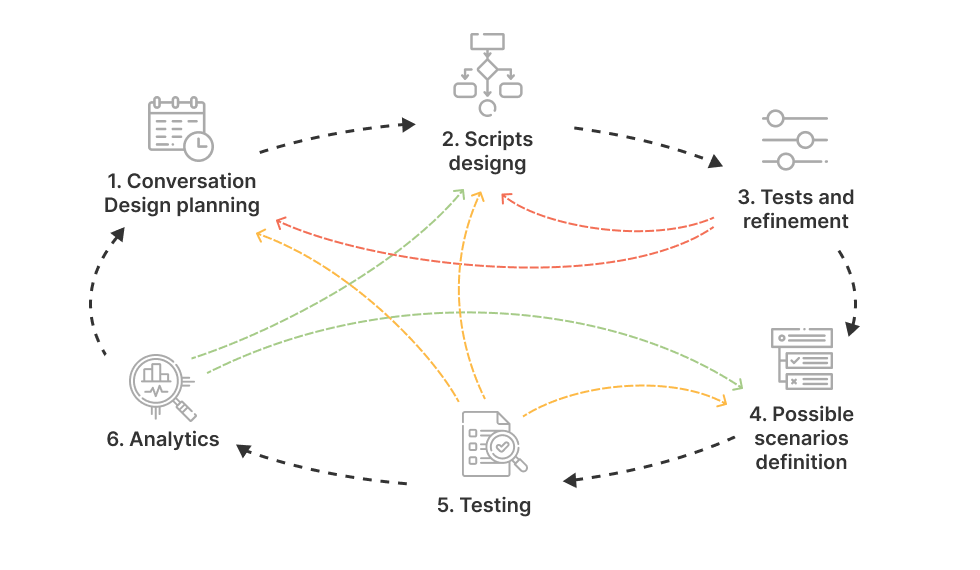Welcome to part 2 of our Conversation Design discussion. In part 1 we learned about multimodal Conversational AI assistants: best use cases and their future. Today we’ll dive into AI-powered voice assistants: how to build and test new customer experiences, collect feedback on it and make a decision to invest in Conversational AI solutions.
Today, voice agents are commonly chatbots but with voice communication, so they help you with certain quick faqs and tasks, but if we look at that realm of the future it will be that multi-sensory multimodal experience. It’s not just about the modality, it’s about what other factors come into play, such as what we’ve seen from the Metaverse. With mixed reality where there’s so much opportunity, how do companies support that in the best way? Check out our Voice Assistant Use Cases for Business to automate repetitive or labor-intensive tasks.
Table of Contents
Voice agents and other potential user interactions to provide better customer experience
We often see that companies start off with a chatbot development, and then they often replicate the experience to a voice channel. A big mistake companies make is not recognizing and designing for cognitive load. With listening humans can remember around 2-3 pieces of information in one communication, but when we’re engaging with text-based communications, we can give users 5-9+ pieces of information. Additionally, they can read and re-read the prompt without the bot having to do it for them.
Cognitive load is a big challenge with voice agents because some of the voices, mostly default ones, may sound a little monotone to users. As time goes on we are however seeing more human-like voices come out on assistants that offer better inflections that help users focus and listen. By having those variations of voices it might give a little bit more flexibility for Conversation Design in terms of how much more information we can give a user than today.
Testing in Conversation Design process
Much of the quality in Conversation Design experiences lies in quality testing, especially in voice. If you’re creating conversational flows, it’s essential to act and read out your dialogs, this is the basics of conversation design process. We recommend back to back conversations so users can organically respond to prompts without looking at the speaker’s facial expressions. Check out more insights from our specialists in optimizing chatbot interactions for troubleshooting to level up the answers of your bot.
These testing exercises allows the designer to address potential points of friction, confusion and immediately correct them and retest all before launching the experience. This mitigates unanticipated errors and promotes strong conversation and completion of your assistant’s conversational flows.

How to collect feedback about your AI chatbot or voice agent?
Collecting feedback is the most critical step in the Conversation Design process in ensuring your conversational solution is useful and enjoyable for customers to use. As your solution expands in features, user feedback will allow your team to make mindful and impactful decisions to further improve the customer experience.
A common mistake companies make is having their voice or chat bot after every prompt ask the user for initial feedback on if it answered their question or was helpful or not. This requires the customer to give multiple pieces of feedback in one interaction which can quickly cause user frustration or have them ignore it entirely. Think of your own experiences with talking to human agents, do they ask you how they did every minute? It’s unlikely they do because сonversation interactions would be robotic and it’s uncommon for humans to give feedback multiple times in one conversation and it turns into a very robotic experience.
It’s challenging enough for users to fill out a single survey at the end of an experience, so asking for multiple rounds of feedback is even less likely.
A great way to ask customer feedback is at the end of newly launched flows or in the form of an ‘Anything Else’ menu at the end of longer, more complex flows. As more feedback is received on new flows, conversation designers and bot tuners can further optimize the experience and once enough good feedback is received the feedback prompt is removed.
How to make a decision on if your business should invest in Conversational AI?
Before investing in conversational AI, firms should consider the following factors:
- Technical abilities and constraints: The ability to integrate conversational AI solution and connect it via API is a must. If your firm has limited technology with little opportunities for the bot to integrate with systems that end users engage with today, your user experience may be slower than current state and expected ROI will be constrained. Remember, if users are being pushed to switch to a chat or voice channel, then that experience must be an improved version of current state otherwise customers won’t make the channel shift.
- Economic viability: Ensure your firm has the financial investment to support discovery, design and development and optimization costs for a conversational AI solution. More importantly, that there is a budget to support ongoing improvements and new feature builds.
Check out your potential cost savings by implementing a chatbot solution for customer supportCalculate ROI

It’s so critical for businesses to ensure their internal systems are flexible enough to allow for integrations. These will help produce frictionless, impactful and engaging experiences that end-users will want to interact with. This is why conversation design is so critical in the bot building process, so that what is launched is something that these users will want to use.






